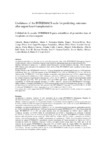Mostrar o rexistro simple do ítem
Usefulness of the INTERMACS scale for predicting outcomes after urgent heart transplantation
| dc.contributor.author | Barge-Caballero, Eduardo | |
| dc.contributor.author | Paniagua-Martín, María J. | |
| dc.contributor.author | Marzoa Rivas, Raquel | |
| dc.contributor.author | Campo-Pérez, Rosa | |
| dc.contributor.author | Rodríguez-Fernández, José Ángel | |
| dc.contributor.author | Pérez-Pérez, Alberto | |
| dc.contributor.author | García-Bueno, Lourdes | |
| dc.contributor.author | Blanco-Canosa, Paula | |
| dc.contributor.author | Grille Cancela, Zulaika | |
| dc.contributor.author | Solla-Buceta, Miguel | |
| dc.contributor.author | Juffé-Stein, Alberto | |
| dc.contributor.author | Herrera-Noreña, José M. | |
| dc.contributor.author | Cuenca, José J. | |
| dc.contributor.author | Muñiz, Javier | |
| dc.contributor.author | Castro-Beiras, Alfonso | |
| dc.contributor.author | Crespo-Leiro, María Generosa | |
| dc.date.accessioned | 2015-08-31T07:30:06Z | |
| dc.date.available | 2015-08-31T07:30:06Z | |
| dc.date.issued | 2011 | |
| dc.identifier.citation | Barge-Caballero E, Paniagua-Martín MJ, Marzoa Rivas R, Campo-Pérez R, Rodrígue-Fernández JA, Pérez-Pérez A, et al. Usefulness of the INTERMACS scale for predicting outcomes after urgent heart transplantation. Rev Esp Cardiol. 2011;64(3):193-200 | es_ES |
| dc.identifier.uri | http://hdl.handle.net/2183/14892 | |
| dc.description.abstract | [Abstract] Introduction and objectives. Our aim was to assess the prognostic value of the INTERMACS (Interagency Registry for Mechanically Assisted Circulatory Support) scale in patients undergoing urgent heart transplantation (HT). Methods. Retrospective analysis of 111 patients treated with urgent HT at our institution from April, 1991 to October, 2009. Patients were retrospectively assigned to three levels of the INTERMACS scale according to their clinical status before HT. Results. Patients at the INTERMACS 1 level (n = 31) more frequently had ischemic heart disease (p = 0.03) and post-cardiothomy shock (p = 0.02) than patients at the INTERMACS 2 (n = 55) and INTERMACS 3-4 (n = 25) levels. Patients at the INTERMACS 1 level showed higher preoperative catecolamin doses (p = 0.001), a higher frequency of use of mechanical ventilation (p < 0.001), intraaortic balloon (p = 0.002) and ventricular assist devices (p = 0.002), and a higher frequency of preoperative infection (p = 0.015). The INTERMACS 1 group also presented higher central venous pressure (p = 0.02), AST (p = 0.002), ALT (p = 0.006) and serum creatinine (p < 0.001), and lower hemoglobin (p = 0.008) and creatinine clearance (p = 0.001). After HT, patients at the INTERMACS 1 level had a higher incidence of primary graft failure (p = 0.03) and postoperative need for renal replacement therapy (p = 0.004), and their long-term survival was lower than patients at the INTERMACS 2 (log rank 5.1, p = 0.023; HR 3.1, IC 95% 1.1-8.8) and INTERMACS 3-4 level (log rank 6.1, p = 0.013; HR 6.8, IC 95% 1.2-39.1). Conclusions. Our results suggest that the INTERMACS scale may be a useful tool to stratify postoperative prognosis after urgent HT. | es_ES |
| dc.description.abstract | [Resumen] Introducción y objetivos. Analizar el valor pronóstico de la escala INTERMACS (Interagency Registry for Mechanically Assisted Circulatory Support) en pacientes tratados con trasplante cardiaco urgente. Métodos. Análisis retrospectivo de 111 pacientes tratados con trasplante cardiaco urgente en nuestro centro entre abril de 1991 y octubre de 2009. Se asignó retrospectivamente a los pacientes a tres niveles de la escala INTERMACS en función de su situación clínica previa al trasplante cardiaco. Resultados. Los pacientes del grupo INTERMACS 1 (n = 31) presentaban mayor frecuencia de cardiopatía isquémica (p = 0,03) y shock tras cardiotomía (p = 0,02) que los pacientes del grupo INTERMACS 2 (n = 55) y los pacientes del grupo INTERMACS 3-4 (n = 25), así como mayores dosis de catecolaminas (p = 0,001), mayor empleo de ventilación mecánica (p < 0,001), balón de contrapulsación (p = 0,002) y dispositivos de asistencia ventricular (p = 0,002) y mayores tasas de infección preoperatoria (p = 0,015). El grupo INTERMACS 1 también mostraba mayores cifras de presión venosa central (p = 0,02), GOT (p = 0,002), GPT (p = 0,006) y creatinina (p < 0,001) y menores cifras de hemoglobina (p = 0,008) y aclaramiento de creatinina (p = 0,001). Tras el trasplante cardiaco, los pacientes del grupo INTERMACS 1 presentaron mayores incidencias de fracaso primario del injerto (p = 0,03) y necesidad de terapia de sustitución renal (p = 0,004), y su supervivencia a largo plazo fue menor que la de los pacientes de los grupos INTERMACS 2 (log rank = 5,1; p = 0,023; razón de riesgos [HR] = 3,1; intervalo de confianza [IC] del 95%, 1,4-6,8) e INTERMACS 3-4 (log rank = 6,1; p = 0,013; HR = 4; IC del 95%, 1,3-12,3). Conclusiones. Nuestros resultados indican que la escala INTERMACS resulta útil para estratificar el pronóstico postoperatorio tras el trasplante cardiaco urgente. | es_ES |
| dc.language.iso | eng | es_ES |
| dc.publisher | Elsevier | es_ES |
| dc.relation.uri | http://dx.doi.org/10.1016/j.rec.2010.08.001 | es_ES |
| dc.rights | Creative Commons Licence | es_ES |
| dc.rights | Reconocimiento-NoComercial-SinObraDerivada 4.0 Internacional | |
| dc.rights.uri | http://creativecommons.org/licenses/by-nc-nd/4.0/ | |
| dc.subject | INTERMACS | es_ES |
| dc.subject | Heart transplantation | es_ES |
| dc.subject | Heart failure | es_ES |
| dc.subject | Prognosis | es_ES |
| dc.subject | Transplante cardiaco | es_ES |
| dc.subject | Insuficiencia cardiaca | es_ES |
| dc.subject | Pronóstico | es_ES |
| dc.title | Usefulness of the INTERMACS scale for predicting outcomes after urgent heart transplantation | es_ES |
| dc.type | info:eu-repo/semantics/article | es_ES |
| dc.rights.access | info:eu-repo/semantics/openAccess | es_ES |
Ficheiros no ítem
Este ítem aparece na(s) seguinte(s) colección(s)
-
GI- GRINCAR - Artigos [226]






